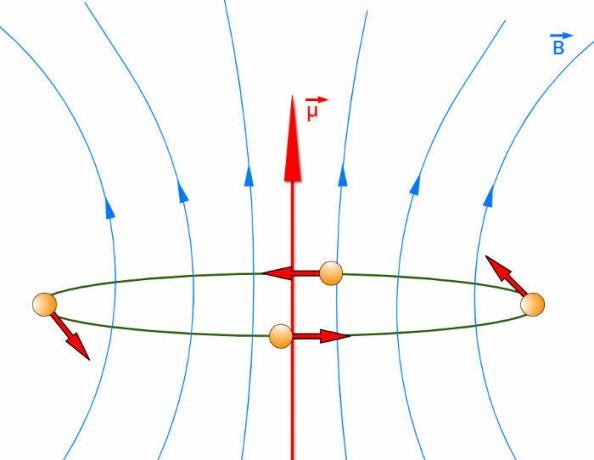Magnetism is a set of phenomena related to the interaction between magnetic fields, which are the regions of space that are under the influence of electric currents or from the magnetic moments of elementary molecules or particles.
The movement of electrical charges is what gives rise to magnetic phenomena. Since they are never stationary, atoms produce their own magnetic field. Furthermore, elementary particles such as protons, neutrons and electrons also have an intrinsic magnetic field, but of different origin. The magnetic field of these particles comes from a quantum property called spin.
See too: Modern physics
Examples of magnetism
We can provide some examples that illustrate situations where magnetism is present.
Navigation using the compass: the compass is a small ferromagnetic needle that rotates because of the Earth's magnetic field;
Attraction of small pieces of metal by magnets: magnets attract metals with great intensity because of their ferromagnetic behavior;
Attraction and repulsion between magnets:
the eponymous poles of the magnets repel each other, since the magnetic dipole vectors of their domains are arranged in opposite directions;Earth's magnetic field: the Earth's magnetic field exists because of the relative rotation between the Earth's core and its outer layers, which rotate at different speeds.
Magnetism in Physics
Magnetism is the physical phenomenon that explains the attraction between metals and magnets, for example. These materials are able to attract each other thanks to the spatial arrangement of the magnetic dipole moment vectors (μ) that are found inside these materials.
the moment of dipolemagnetic is a vector that points towards the north pole of a magnetic field. This magnitude is produced when an electrical charge moves in a closed circuit, as shown in the figure below:

The movement of a charge in a closed circuit produces a magnetic dipole moment.
Some materials may feel attracted or even repelled by others depending on how their magnetic dipole moments are aligned within them. This configuration of magnetic dipole moments is what we call state ofmagnetization. There are several states of magnetization, such as the ferromagnetism, antiferromagnetism,diamagnetic and paramagnetic.
When dealing with materials that have magnetic properties, it is common to talk about Domainsmagnetic, which are small pieces of material where all the molecules that are close together have their magnetic moments aligned in a single direction. The figure below shows the orientations of the magnetic dipole moments in the magnetic domains for each type of material mentioned. Watch:

Magnetic domains for different states of magnetization.
When exposed to an external magnetic field source such as a magnet, these materials react in different ways.
Ferromagnetic materials: These materials already have their magnetic domains aligned, even without the presence of an external magnetic field. When approached to a magnet, they are strongly attracted, in addition, ferromagnetic materials lose their magnetization if heated above the temperature of Curie, a temperature at which magnetic domains lose their orientation. Examples: iron, cobalt, nickel.
Antiferromagnetic materials: Unlike ferromagnetic materials, these materials are strongly repelled by external magnetic fields. Examples: manganese, chrome.
Diamagnetic materials: In these materials, the magnetic domains are free to rotate in the presence of a magnetic field, however, the magnetic dipole moments of this material line up opposite the external magnetic field and are therefore repelled by magnets. Examples: copper, silver.
Paramagnetic materials: In paramagnetic materials, the magnetic domains are naturally disoriented. In the presence of an external magnetic field, they can align themselves, being slightly attracted by the magnets, as long as there is proximity between them. Examples: aluminum, magnesium.
Lookalso:What is electricity?
What is magnetism for?
Magnetism has numerous applicationstechnological. Various electrical circuits, such as transformers, make use of the magnetic properties of materials to work correctly. In the case of transformers, for example, the ferromagnetic property of iron is taken advantage of: when you apply a magnetic field to this material, it reinforces it by adding a magnetic field to it induced.
Magnetism is also fundamental for the functioning of electric motors, for recording information on hard disks, such as cassette and VHS tapes, magnetic cards, among others.

Hard drives make use of magnetic recording to store information.
history of magnetism
Between 600 a. Ç. and 1599 d. Ç. mankind discovered the existence of magnetite, a mineral that exhibits ferromagnetic properties. During this same period, the Chinese made use of compasses to guide their navigations.
For centuries after the discovery of magnetic phenomena, magnetism was treated as an independent phenomenon, unrelated to electricity. Today, thanks to the studies of the electromagnetism, we know that the electrical and magnetic phenomena share the same essence and together they give rise to electromagnetic waves. Furthermore, it was only after the 18th century that magnetism came to be understood more clearly. During this period, studies started to be developed quantitatively.
WilliamGilbert he was one of the first scientists to study magnetism according to the scientific method. He found that the Earth behaved like a big magnet. Further studies on terrestrial magnetism were conducted by Carl Friedrich gauss, author of one of the equations that support electromagnetism. In addition to these, several experiments were carried out by André Marie Ampere.
Between 1820 and 1829, Hans Christian Orsted got the firstevidenceexperimental that linked magnetism to electrical phenomena: accidentally, he noticed that electrical current in a wire caused a nearby compass to move. His studies allowed the emergence of the first known electric motors.
Between 1830 and 1839, studies on magnetism were driven by research from Michael Faraday. Among his discoveries and inventions, the importance of creating the firsttransformer, although quite primitive, and a generator of electric current, based on the electromagnetic induction.
By Me. Rafael Helerbrock
Source: Brazil School - https://brasilescola.uol.com.br/o-que-e/fisica/o-que-e-magnetismo.htm

